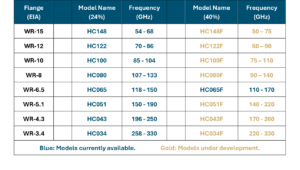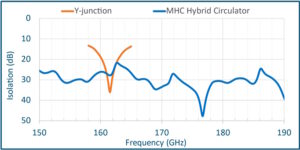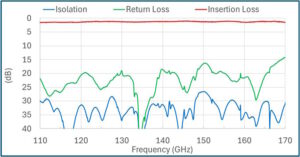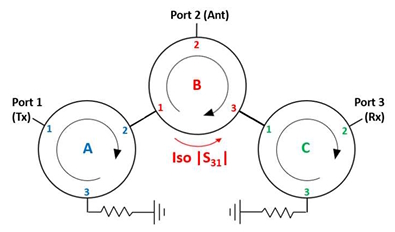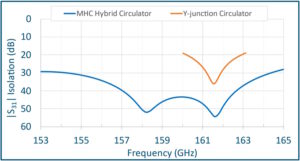Micro Harmonics markets two types of broadband mm-wave hybrid circulators. One type has a 24% fractional bandwidth and is available in every standard waveguide band from WR-15 through WR-3.4 as indicated in the table below. The second type is designed to cover full rectangular waveguide bands having fractional bandwidths in excess of 40%. The first prototype of the full band model was tested in the WR-6.5 band. Additional full band models are planned for development in every band from WR-15 to WR-3.4.
Historically, the Y-junction has been the most common type of circulator at mm-wave frequencies. A Y‑junction comprises a ferrite core located at the convergence of three waveguides. At the higher mm‑wave frequencies, the Y-junction has a narrow bandwidth and is difficult to tune. The theory of operation and architecture of the hybrid circulator are very different from the Y-junction. The hybrid circulator comprises a Faraday rotator and an orthomode transducer (OMT). Since both the Faraday rotator and OMT are inherently broadband, the hybrid circulator is also broadband. A comprehensive technical description is given by D. W. Porterfield, “Broadband Millimeter-Wave Hybrid Circulators,” IEEE Trans. Microw. Theory Techn., vol. 71, no. 8, pp. 3501-3507, Aug. 2023. The hybrid circulator technology is patented.
The bar chart below shows fractional bandwidths for the hybrid circulators and Y-junction circulators. The bandwidth of the Y-junction circulator steadily drops as the frequency increases, approaching only 2% at 160 GHz. We define the 20 dB bandwidth as the band over which the isolation between circulator ports is more than 20 dB.
RF test data from one of our WR-5.1 hybrid circulators are shown in the lower graph along with test data from a Y-junction circulator for comparison. This hybrid model is designed for 24% bandwidth. Insertion loss of our WR-5.1 hybrid circulator is less than 2.2 dB.
Measured RF Test data for the full band WR-6.5 hybrid circulator are shown in the graph below. Isolation is greater than 20 dB. Return loss is greater than 15 dB. Insertion loss is less than 1.5 dB across most of the band. This level of performance has never been achieved before in a D band circulator.
At Micro Harmonics, the Y-junction circulator is being replaced by the broad band hybrid circulator. But for narrow bandwidth applications, we continue to offer a line of Y-junction circulators covering sub-bands within the WR-15, WR-12, WR-10, and WR-8 bands (50-140 GHz). These circulators exhibit state-of-the-art performance in terms of high isolation, low-insertion loss, and low port reflections. Special order designs optimized for specific sub-bands are considered on a case-by-case basis.
High Isolation Hybrid Circulators
In high-power transceiver systems, the sensitive receiver (Rx) must be isolated from the high-power transmitter (Tx) signal. The 20 dB isolation provided by Y-junction circulators is insufficient. Circulators employing multiple Y-junctions can achieve some increased isolation parameters, but the isolation of the
receiver from the transmitter signal cannot be increased by using multiple junctions.
To understand why, consider the schematic for a triple junction circulator. The three circulators are designated “A”, “B”, and “C”. Circulators “A” and “C” function as isolators since their third ports are terminated with matched loads. A single isolation path on circulator “B”, |S31|, blocks the transmit signal from reaching the receiver. Regardless of how many junctions are used, a multi-
Y-junction circulator can only have a single isolation path protecting the receiver (Rx) from the transmitter (Tx).
But Micro Harmonics unique hybrid circulators can be designed to achieve high S31 isolation over broad bandwidths. HFSS simulation data are shown below for a hybrid circulator with S31 isolation of more than 40 dB over the band 157-162 GHz. Measured data from a Y-junction are shown for comparison. High isolation hybrid circulators can be designed up to 330 GHz. The hybrid circulator technology is patented and only available from Micro Harmonics. Please contact us for more information.

